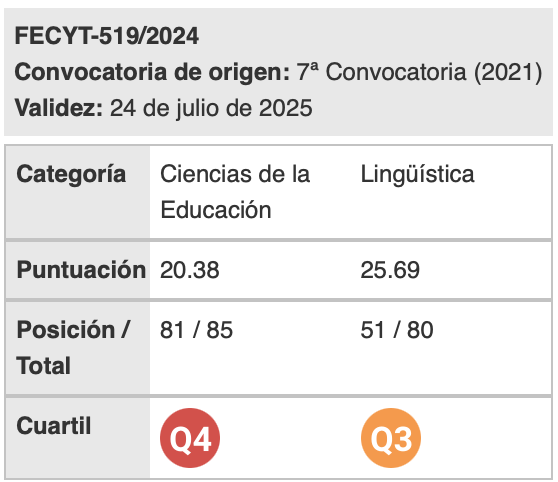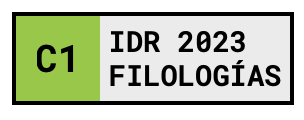Didactic Audiovisual Translation in Teacher Training
Palabras clave:
TAV didáctica, doblaje, audiodescripción, TRADILEX, formación de profesoresResumen
En las dos últimas décadas, la participación activa de los alumnos a través de la traducción audiovisual didáctica en la enseñanza de lenguas extranjeras (L2) ha recibido una atención creciente por parte de académicos y profesores. La mayoría de las modalidades de traducción audiovisual (TAV) -subtitulado, doblaje, audio descripción (AD), subtítulos para sordos (SPS) y voces solapadas- pueden emplearse como recurso didáctico en este contexto y existen directrices para su aplicación (Talaván, 2013, 2020). La investigación empírica se ha centrado en los beneficios de la TAV didáctica para la mejora de las habilidades lingüísticas individuales e integradas tanto en contextos presenciales como en línea, siendo el inglés el idioma principal implicado en las tareas pedagógicas de la mayoría de los estudios experimentales existentes (Lertola, 2019).
Recientemente, un proyecto relacionado, TRADILEX (Traducción Audiovisual como Recurso Didáctico en la Enseñanza de Lenguas Extranjeras), liderado por el grupo de investigación TRADIT de la UNED, ha sido financiado por el Ministerio de Ciencia e Innovación de España con una duración de 3 años. El objetivo principal de TRADILEX es evaluar el grado de mejora de la L2 en términos de habilidades lingüísticas comunicativas y de mediación gracias al uso de tareas didácticas de TAV. Con este fin, se está pilotando una propuesta metodológica escrupulosamente diseñada, que incluye planes de clase sobre diversas modalidades de TAV (es decir, subtitulado, voces solapadas, doblaje, AD y SPS), con alumnos de inglés como L2 de nivel B1 y B2 en contextos educativos no formales, en centros de idiomas universitarios de toda España.
Los profesores desempeñan un papel fundamental en TRADILEX, ya que son facilitadores específicamente formados en el proceso de aprendizaje. Muchos profesores creen que las tareas de TAV podrían integrarse en el currículo de L2 si se proporciona una formación docente adecuada (Alonso-Pérez y Sánchez-Requena, 2018). Sin embargo, cabe destacar que la formación del profesorado ha sido menos tratada en la literatura (Lertola, en prensa). En este contexto, este trabajo presentará una experiencia de formación docente en línea sobre TAV didáctica realizada como estudio piloto de TRADILEX, en la que participaron 12 profesores de secundaria de lenguas extranjeras en formación en una institución superior de Suiza. La formación del profesorado, de un día de duración, tenía como objetivo introducir a los futuros profesores en el uso pedagógico de las tareas de TAV mediante la presentación y el desarrollo de un plan de clase de doblaje y uno de AD, de nivel B1 y B2 respectivamente. En este artículo se analizan y discuten los datos recogidos a través de un cuestionario rellenado por los participantes, la evaluación de sus tareas de TAV y observaciones estructuradas y no estructuradas. Las observaciones se recogieron a través de dos rúbricas de observación ad hoc (una para cada plan de clase) rellenadas por uno de los dos profesores-investigadores y su profesor como único observador, y a través de una entrevista grupal y notas individuales escritas por los sujetos al finalizar el curso. Los resultados de este estudio a pequeña escala son prometedores y exigen un análisis más profundo del papel de la TAV didáctica en la formación de profesores, tanto para los profesionales interesados en utilizarla con sus alumnos como para los cursos de formación de profesores en general.
Descargas
Citas
Alonso-Pérez, R. & Sánchez-Requena, A. (2018). Teaching foreign languages through audiovisual translation resources: Teachers’ perspectives. Applied Language Learning, 28(2), 1–24.
Baños, R., Marzà, A., & Torralba, G. (2021). Promoting plurilingual and pluricultural competence in language learning through audiovisual translation. Translation and Translanguaging in Multilingual Contexts, 7(1), 65–85.
Baños, R., & Sokoli, S. (2015). Learning foreign languages with ClipFlair: Using captioning and revoicing activities to increase students’ motivation and engagement. In K. Borthwick, E. Corradini & A. Dickens (Eds.), 10 Years of the LLAS Elearning Symposium: Case Studies in Good Practice. (pp. 203–213). Voillans: Research-publishing.net.
Dörnyei, Z. (2010). Questionnaires in second language research: Construction, administration, and processing (2nd ed.). Abingdon: Routledge.
Dörnyei Z. (2007). Research methods in applied linguistics. Oxford: Oxford University Press.
Fernández-Costales, A. (2021). Subtitling and dubbing as teaching resources in CLIL in primary education: The teachers’ perspective. Porta Linguarum, 36, 175–192.
Incalcaterra McLoughlin, L. (2019). Audiovisual translation in language teaching and learning. In L. Pérez-González (Ed.), The Routledge Handbook of Audiovisual Translation. (pp. 483–497). Oxon: Routledge.
Lertola, J. (2021). Free commentary to enhance writing and speaking skills in EFL teacher training. ESP Across Cultures, 18, 125-140. <http://dx.doi.org/10.4475/0062_7 > [16/09/2022].
Lertola, J. (2019). Audiovisual translation in the foreign language classroom: Applications in the teaching of english and other foreign languages. Voillans: Research-publishing.net.
Talaván, N., & Lertola, J. (2022). Audiovisual translation as a didactic resource in foreign language education. A methodological proposal. Encuentro Journal, 30, 23–39. <https://erevistas.publicaciones.uah.es/ojs/index.php/encuentro> [16/09/2022].
Talaván, N. (2020). The didactic value of AVT in foreign language education. In Ł. Bogucki & M. Deckert (Eds.) The Palgrave Handbook of Audiovisual Translation and Media Accessibility. (pp. 567–592). Cham: Palgrave Macmillan.
Talaván, N. (2013). La subtitulación en el aprendizaje de lenguas extranjeras. Barcelona: Octaedro.
Zabalbeascoa, P., Sokoli, S., & Torres-Hostench, O. (2012). Conceptual framework and pedagogical methodology. CLIPFLAIR Foreign Language Learning Through Interactive Revoicing and Captioning of Clips. E-Repositori: Universitat Pompeu Fabr
Descargas
Publicado
Cómo citar
Número
Sección
Licencia
Aquellos autores/as que tengan publicaciones con esta revista, aceptan los términos siguientes:
- Los autores/as conservarán sus derechos de autor y garantizarán a la revista el derecho de primera publicación de su obra, el cuál estará simultáneamente sujeto a la Licencia de reconocimiento de Creative Commons que permite a terceros compartir la obra siempre que se indique su autor y su primera publicación esta revista.
- Los autores/as podrán adoptar otros acuerdos de licencia no exclusiva de distribución de la versión de la obra publicada (p. ej.: depositarla en un archivo telemático institucional o publicarla en un volumen monográfico) siempre que se indique la publicación inicial en esta revista.
- Se permite y recomienda a los autores/as difundir su obra a través de Internet (p. ej.: en archivos telemáticos institucionales o en su página web) antes y durante el proceso de envío, lo cual puede producir intercambios interesantes y aumentar las citas de la obra publicada. (Véase El efecto del acceso abierto).

Revista de Lenguas para fines específicos is licensed under a Creative Commons Reconocimiento-NoComercial-SinObraDerivada 4.0 Internacional License.

























